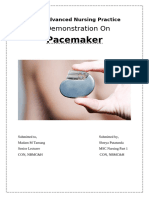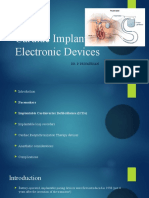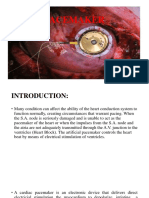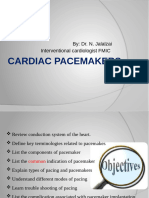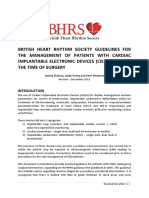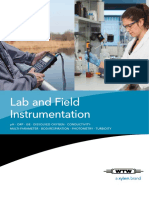Complications of Much Needed Rhinitis
Complications of Much Needed Rhinitis
Uploaded by
lolCopyright:
Available Formats
Complications of Much Needed Rhinitis
Complications of Much Needed Rhinitis
Uploaded by
lolCopyright
Available Formats
Share this document
Did you find this document useful?
Is this content inappropriate?
Copyright:
Available Formats
Complications of Much Needed Rhinitis
Complications of Much Needed Rhinitis
Uploaded by
lolCopyright:
Available Formats
Page 2 of 8 Kotsakou et al.
Pacamaker and pneumothorax
permanent cardiac pacing devices: (I) single-chamber Table 1 Absolute and relative indications
PMs-VVI: one pacing lead is implanted in the right Absolute indications
ventricle or right atrium; (II) dual-chamber PMs-DDD: Sick sinus syndrome
two leads are implanted (in the right ventricle and in the
Symptomatic sinus bradycardia
right atrium); this is the most common type of implanted
Tachycardia-bradycardia syndrome
PM, (III) biventricular PMs-BiV, also called cardiac
Atrial fibrillation with sinus node dysfunction
resynchronization therapy (CRT): in addition to single- or
Complete atrioventricular block (third-degree block)
dual-chamber right heart pacing leads, a lead is advanced
to the coronary sinus for left ventricular epicardial pacing. Chronotropic incompetence
CRT-P includes pacing and CRT-D includes defibrillation. Prolonged QT syndrome
CRT is mainly implanted to patients with heart failure, Cardiac resynchronization therapy with biventricular pacing
improving symptoms and quality of life (3,4). Indications Relative indications
for implantation of permanent PMs divided into three Cardiomyopathy (hypertrophic or dilated)
classes, as defined by the ACC/AHA/HRS guidelines for Severe refractory neurocardiogenic syncope
device-based therapy of cardiac rhythm abnormalities (6-8).
Absolute and relative indications are shown in Table 1.
An ICD is recommended as primary therapy in a subcutaneous pocket is created, where the generator will
survivors of cardiac arrest due to ventricular fibrillation or be implanted. After successful vein access, a guide wire
hemodynamically unstable ventricular tachycardia. ICD is advanced and placed on the right atrium or the vena
indications are secondary prophylaxis against sudden cardiac caval area under fluoroscopy. A second guide wire can
death and primary prophylaxis (9).
be positioned, if necessary, via the same route either by a
second puncture or by a double-wire technique in which
Technique of implantation two guide wires are inserted through the first sheath.
A sheath and dilator are advanced, and when sheath
A PM consists of: (I) a pulse generator which contains all
is set in the right place the guide wire and the dilator
the computerized information to sense the intrinsic cardiac
are retracted. Then the lead is inserted into the sheath
electric potentials and to stimulate cardiac contraction, and
and advanced under fluoroscopy to the appropriate heart
a battery; (II) leads, which are wires with electrodes at their
chamber, where is attached to the endocardium either
tips. These leads connect the heart to the generator and
passively with tines or actively via screw-in leads. When
transfer all the data between them (2).
implanting a DDD, the ventricular lead is the first to be
Implantation of permanent PM is performed in a
placed. When leads are securely placed, then the sheath
cardiac catheterization laboratory under local or less
common general anesthesia and is considered to be a is removed. Specifics tests for sensing and pacing are held
minimally invasive procedure. Transvenous access to the and to avoid stimulation of the diaphragm, pacing is set at
heart chambers is the preferable technique, commonly 10 V. The lead is sewn with a nonabsorbable suture to the
via a percutaneous approach of the subclavian vein, the underlying tissue and afterwards, the generator is placed
cephalic vein (cut-down technique), or rarely the axillary to the pocket and connected to the lead. Last, the incision
vein, the internal jugular vein or the femoral vein (4). In is closed with absorbable sutures and an arm immobilizer
some cases both subclavian vein and cephalic vein are is applied for 12-24 hours. The cut-down technique of the
punctured. The most common transvenous route is the cephalic vein demands extensive skin and muscle dissection
left or right subclavian vein, entered at the junction of the to visualize the vein. Occasionally, PM can be implanted
middle and inner thirds, where the first rib and the clavicle surgically via a thoracotomy, and the generator is placed in
are joined. The vein is usually blindly punctured, unless the abdominal area. Antibiotic prophylaxis is compulsory
there are certain anatomical abnormalities, such as chest for device implantation, routinely cefazolin 1 g i.v. 1 hour
wall or clavicle deformation. In these cases an initial brief prior to the procedure, or alternatively 1 g vancomycin
intravenous contrast injection-venography is attempted i.v. in case of allergy to penicillin and/or cephalosporins.
in the peripheral arm vein. After the puncture, a small The day following the implantation, a chest radiograph in
incision 3.8-5.1 cm is made in the infraclavicular area and standing position anteroposterior and lateral is performed,
© Annals of Translational Medicine. All rights reserved. www.atmjournal.org Ann Transl Med 2015;3(3):42
You might also like
- Sodium Sulphate Production LineDocument19 pagesSodium Sulphate Production LineHamdael100% (2)
- Cardiac Electrical Assistive DevicesDocument14 pagesCardiac Electrical Assistive DevicesaprnworldNo ratings yet
- OAP NCII Summative 1 Final TermDocument1 pageOAP NCII Summative 1 Final TermRocky B AcsonNo ratings yet
- C57.111-1989 Silicone OilDocument20 pagesC57.111-1989 Silicone Oil434lapNo ratings yet
- Cardiac ICDsDocument9 pagesCardiac ICDssundaripremkumarNo ratings yet
- 11.pacemakers and Defibrillators - DR - RangalakshmiDocument8 pages11.pacemakers and Defibrillators - DR - RangalakshmiJesmine KonnaeckalNo ratings yet
- PacemakerDocument20 pagesPacemakerputatundashreya2016No ratings yet
- Arritmia SVDocument17 pagesArritmia SVCésar Lobo TarangoNo ratings yet
- Type of PacemakerDocument26 pagesType of PacemakerMohammad AlmuhaiminNo ratings yet
- How To: A Practical Guide To Cardiac Conduction Devices On Chest RadiographDocument7 pagesHow To: A Practical Guide To Cardiac Conduction Devices On Chest RadiographAndreea TeodorescuNo ratings yet
- Mathew 2019Document13 pagesMathew 2019Teodor SlabuNo ratings yet
- Cardiac Implantable Electronic DevicesDocument49 pagesCardiac Implantable Electronic DevicespriyathasanNo ratings yet
- 1 s2.0 S0736467906006445 PDFDocument7 pages1 s2.0 S0736467906006445 PDFDiego Fernando Escobar GarciaNo ratings yet
- Pacemakers: Acute Ischemic Heart FailureDocument2 pagesPacemakers: Acute Ischemic Heart FailureZeoFateXNo ratings yet
- Anaesthetic Management of Patients With Cardiac Pacemakers and Defibrillators For Noncardiac SurgeryDocument12 pagesAnaesthetic Management of Patients With Cardiac Pacemakers and Defibrillators For Noncardiac SurgeryzaheerNo ratings yet
- Pacemaker 180508042454Document86 pagesPacemaker 180508042454padmaNo ratings yet
- Ventricular TachycardiaDocument4 pagesVentricular TachycardiaDicky SaputraNo ratings yet
- Kalyanam Shivkumar Catheter Ablation of VentricularDocument10 pagesKalyanam Shivkumar Catheter Ablation of Ventricularrvp.180088No ratings yet
- Cardiac Pace MakersDocument83 pagesCardiac Pace MakersNejat Medical MediaNo ratings yet
- Cardiovascular System CPTDocument20 pagesCardiovascular System CPTNaveen ChNo ratings yet
- CIED Surgical Guidance Dec21Document16 pagesCIED Surgical Guidance Dec21SamNo ratings yet
- Pacemakers and Implantable Cardioverter DefibrillatorsDocument10 pagesPacemakers and Implantable Cardioverter Defibrillatorsnoorhadi.n10No ratings yet
- Transcutaneous Cardiac PacingDocument8 pagesTranscutaneous Cardiac PacingistiNo ratings yet
- A Tragic Case of Wearable Cardioverter-Defibrillator FailureDocument5 pagesA Tragic Case of Wearable Cardioverter-Defibrillator FailureDennis SanchezNo ratings yet
- Approach To Ventricular ArrhythmiasDocument18 pagesApproach To Ventricular ArrhythmiasDavid CruzNo ratings yet
- Role of Ablation Therapy in VentricularDocument21 pagesRole of Ablation Therapy in VentricularMANOEL POLYCARPO DE CASTRO NETONo ratings yet
- Ventricular Tachycardia: Jçrgen Schreieck, Gabriele Hessling, Alexander Pustowoit, Claus SchmittDocument28 pagesVentricular Tachycardia: Jçrgen Schreieck, Gabriele Hessling, Alexander Pustowoit, Claus SchmittFuad AlamsyahNo ratings yet
- Placement of Arterial Line: Renae Stafford, MDDocument7 pagesPlacement of Arterial Line: Renae Stafford, MDBotond LukacsNo ratings yet
- Day 3 - APPEC 2021Document413 pagesDay 3 - APPEC 2021GaurieNo ratings yet
- MarcapasosDocument24 pagesMarcapasoshgr1urgenciasNo ratings yet
- 1 s2.0 S1936879821021749 MainDocument15 pages1 s2.0 S1936879821021749 MainVimal NishadNo ratings yet
- Pacemakers & Implantable Cardioverter-Defibrillators (Icds) - Anaesthesia Tutorial of The Week 299 25 November 2013Document8 pagesPacemakers & Implantable Cardioverter-Defibrillators (Icds) - Anaesthesia Tutorial of The Week 299 25 November 2013Anup SasalattiNo ratings yet
- An Important Cause of Wide Complex Tachycardia: Case PresentationDocument2 pagesAn Important Cause of Wide Complex Tachycardia: Case PresentationLuis Fernando Morales JuradoNo ratings yet
- Manejo Perioperatorio de MarcapasosDocument6 pagesManejo Perioperatorio de MarcapasosPao Sofía MoralesNo ratings yet
- Clinmed 23 5 442Document7 pagesClinmed 23 5 442Mey TalabessyNo ratings yet
- PacemakersDocument19 pagesPacemakersAswathy RCNo ratings yet
- Pharmacological Treatment of ArrhytmiaDocument6 pagesPharmacological Treatment of ArrhytmiaLućia-Simona Perić ExOalđeNo ratings yet
- Pacemaker Invasive Cardiac PacingDocument57 pagesPacemaker Invasive Cardiac PacingAhmad Khalil Ahmad Al-SadiNo ratings yet
- Management of Cardiac Implantable Electronic Devices During Interventional Pulmonology Procedures.Document10 pagesManagement of Cardiac Implantable Electronic Devices During Interventional Pulmonology Procedures.Hitomi-No ratings yet
- Pericardiectomy ArticleDocument12 pagesPericardiectomy Articleapi-654112138No ratings yet
- Askep Ps DGN Tindakan Invasif & INB KD 2021Document91 pagesAskep Ps DGN Tindakan Invasif & INB KD 2021gayuspatarru123No ratings yet
- Mastering Temporary Invasive Cardiac Pacing: ClinicalDocument8 pagesMastering Temporary Invasive Cardiac Pacing: ClinicaldenokNo ratings yet
- acs-09-02-81Document8 pagesacs-09-02-81e.silambarasan1No ratings yet
- Defining Culprit Lesion in Non-ST Elevation Myocardial InfarctionDocument6 pagesDefining Culprit Lesion in Non-ST Elevation Myocardial InfarctionrfdvlNo ratings yet
- PacemakerDocument15 pagesPacemakermariet abraham100% (4)
- Anaesthesia Management of Patient of PacemakerDocument92 pagesAnaesthesia Management of Patient of PacemakerSiva KrishnaNo ratings yet
- Cardiac PacingDocument4 pagesCardiac Pacingmrygnvll100% (1)
- Cardiac PeacemakerDocument19 pagesCardiac Peacemakerrana.said2018No ratings yet
- Thoracic Trauma 2Document3 pagesThoracic Trauma 2canndy202No ratings yet
- Pacemakers, Heart BlocksDocument31 pagesPacemakers, Heart BlocksCindyNo ratings yet
- Cardiac Pacing For The SurgeonsDocument46 pagesCardiac Pacing For The SurgeonsRezwanul Hoque BulbulNo ratings yet
- How To Perform A Transseptal Puncture: Mark J EarleyDocument9 pagesHow To Perform A Transseptal Puncture: Mark J EarleyAttilio Del RossoNo ratings yet
- Overdrive PacingDocument24 pagesOverdrive PacingWilliam Perero RodríguezNo ratings yet
- Unit 5 NEWER MODALITIESDocument6 pagesUnit 5 NEWER MODALITIESAakriti SharmaNo ratings yet
- Document (1) Harshal Patil PDF WorkDocument28 pagesDocument (1) Harshal Patil PDF WorkBhanwari DeviNo ratings yet
- - فحوصات شعاعية8 Document7 pages- فحوصات شعاعية8 Noureddine BenarifaNo ratings yet
- Dysrhythmias Chapter 36Document6 pagesDysrhythmias Chapter 36Mahmoud KhelfaNo ratings yet
- Triaje Del Taponamiento Cardíaco ESC 2014Document6 pagesTriaje Del Taponamiento Cardíaco ESC 2014Adriana MendozaNo ratings yet
- PACEMAKERDocument5 pagesPACEMAKERPoonam Thakur100% (1)
- Artificial PacemakerDocument6 pagesArtificial PacemakerNikhil LandeNo ratings yet
- Cardiac Electrophysiology Without FluoroscopyFrom EverandCardiac Electrophysiology Without FluoroscopyRiccardo ProiettiNo ratings yet
- Decoding Cardiac Electrophysiology: Understanding the Techniques and Defining the JargonFrom EverandDecoding Cardiac Electrophysiology: Understanding the Techniques and Defining the JargonAfzal SohaibNo ratings yet
- Catheter Ablation of Cardiac Arrhythmias: Basic Concepts and Clinical ApplicationsFrom EverandCatheter Ablation of Cardiac Arrhythmias: Basic Concepts and Clinical ApplicationsDavid J. Wilber, M.D.No ratings yet
- ARIA guideline 2019Document1 pageARIA guideline 2019lolNo ratings yet
- Rhinitis 2019 Update on CareDocument1 pageRhinitis 2019 Update on CarelolNo ratings yet
- Management of dog bite injuries on humans with ICPDocument8 pagesManagement of dog bite injuries on humans with ICPlolNo ratings yet
- Differences in spirometry interpretation algorithmsDocument6 pagesDifferences in spirometry interpretation algorithmslolNo ratings yet
- Abbreviations used in ENTDocument1 pageAbbreviations used in ENTlolNo ratings yet
- EFSUMB Guidelines on Interventional UltrasoundDocument45 pagesEFSUMB Guidelines on Interventional UltrasoundlolNo ratings yet
- Fanconi Anemia and the Underlying Causes of Genomic InstabilityDocument30 pagesFanconi Anemia and the Underlying Causes of Genomic InstabilitylolNo ratings yet
- Diagnosis and Management of Bacterial Meningitis iDocument9 pagesDiagnosis and Management of Bacterial Meningitis ilolNo ratings yet
- Diagnosing a Red Eye an Allergy or an InfectionDocument5 pagesDiagnosing a Red Eye an Allergy or an InfectionlolNo ratings yet
- Antioxidants in Myocardial Ischemia–Reperfusion InjuryDocument15 pagesAntioxidants in Myocardial Ischemia–Reperfusion InjurylolNo ratings yet
- A Pilot Study of the Effect of Spironolactone TherDocument17 pagesA Pilot Study of the Effect of Spironolactone TherlolNo ratings yet
- PacemakerinsertionDocument9 pagesPacemakerinsertionlolNo ratings yet
- Los_Angeles_Classification_of_Esophagitis_using_ImDocument7 pagesLos_Angeles_Classification_of_Esophagitis_using_ImlolNo ratings yet
- CT Use in MedicineDocument1 pageCT Use in MedicinelolNo ratings yet
- Lower_body_negative_pressure_as_a_model_to_study_pDocument15 pagesLower_body_negative_pressure_as_a_model_to_study_plolNo ratings yet
- Multimodal_management_of_muscle_invasive_bladder_cDocument42 pagesMultimodal_management_of_muscle_invasive_bladder_clolNo ratings yet
- 2013 Settlement Agreement Between David Bashore and Radnor TownshipDocument11 pages2013 Settlement Agreement Between David Bashore and Radnor TownshipthereadingshelfNo ratings yet
- 150 Câu Tìm T Trái Nghĩa: CompulsoryDocument10 pages150 Câu Tìm T Trái Nghĩa: CompulsoryNgọc TrầnNo ratings yet
- Importance of IrrigationDocument10 pagesImportance of Irrigationcharm ramosNo ratings yet
- Use The Following Information For Questions 100 and 101Document4 pagesUse The Following Information For Questions 100 and 101Carlo ParasNo ratings yet
- Installation Instructions For A2Fhc Cable GlandDocument2 pagesInstallation Instructions For A2Fhc Cable GlandFelisbeloNo ratings yet
- MT5023 ERev 01Document7 pagesMT5023 ERev 01George MitioudisNo ratings yet
- Method Statement: (Continuous Flight Auger)Document15 pagesMethod Statement: (Continuous Flight Auger)sawkariqbal100% (1)
- Fossil A-Z BookDocument6 pagesFossil A-Z Bookapi-236358005No ratings yet
- 001 Canadian Pharmacy Review Q&A Content Ver1Document6 pages001 Canadian Pharmacy Review Q&A Content Ver1Safvan Mansuri0% (1)
- Assignment: Riphah International University (Faisalabad Campus)Document5 pagesAssignment: Riphah International University (Faisalabad Campus)Muhammad Uzair GujjarNo ratings yet
- The Black Cat Edgar Allen PoeDocument14 pagesThe Black Cat Edgar Allen Poekatty_b306No ratings yet
- Procurement Specialist Senior Buyer in Sacramento CA Resume Harriet KingDocument2 pagesProcurement Specialist Senior Buyer in Sacramento CA Resume Harriet KingHarrietKing100% (1)
- WTW Lab CatalogDocument188 pagesWTW Lab CatalogSEBASTIAN SALDARRIAGANo ratings yet
- Power Plant Design BasisDocument16 pagesPower Plant Design Basishappale2002100% (2)
- The Ohio State University Wexner Medical Center © 2016Document35 pagesThe Ohio State University Wexner Medical Center © 2016Anna ErlianaNo ratings yet
- Policy On Loan Classification and ProvisioningDocument8 pagesPolicy On Loan Classification and Provisioningrajin_rammsteinNo ratings yet
- 64 Effectiveness of Special Juvenile CrimeDocument16 pages64 Effectiveness of Special Juvenile CrimeKashmala KhanNo ratings yet
- SyllabusDocument9 pagesSyllabusKodjo BarnorNo ratings yet
- William Prentice - Essentials of Athletic Injury Management-McGraw-Hill (2020)Document465 pagesWilliam Prentice - Essentials of Athletic Injury Management-McGraw-Hill (2020)Mạnh TríNo ratings yet
- Veterinary AcupunctureDocument4 pagesVeterinary Acupuncturejk4229No ratings yet
- Research Articles: Biswajit Biswas, Subhadip Roy, Jahur Alam Mondal, and Prashant Chandra SinghDocument7 pagesResearch Articles: Biswajit Biswas, Subhadip Roy, Jahur Alam Mondal, and Prashant Chandra SinghSourashis BiswasNo ratings yet
- (Pub) Creation of An IEC 62304 Compliant Software Development PlanDocument11 pages(Pub) Creation of An IEC 62304 Compliant Software Development PlanAufar RahadiandyNo ratings yet
- HSN223 Prac Exam Student ResourceDocument22 pagesHSN223 Prac Exam Student ResourceTommy CharlieNo ratings yet
- DC ComplaintDocument2 pagesDC ComplaintAlfred ReaudNo ratings yet
- X: A Novel by Ilyasah Shabazz and Kekla Magoon - Chapter SamplerDocument33 pagesX: A Novel by Ilyasah Shabazz and Kekla Magoon - Chapter SamplerCandlewick PressNo ratings yet
- Trans-Anal Suture Rectopexy For Haemorrhoids: Madhura M. KilledarDocument2 pagesTrans-Anal Suture Rectopexy For Haemorrhoids: Madhura M. KilledarLijoeliyasNo ratings yet
- TO Social Cost Benefit AnalysisDocument11 pagesTO Social Cost Benefit AnalysisSatisthkavita NanhuNo ratings yet






